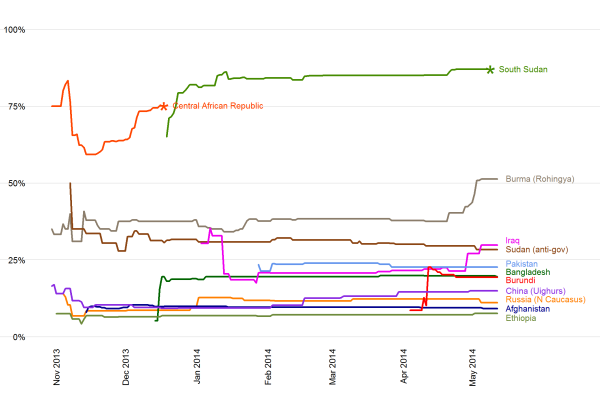For the past couple of years, I have been working as a consultant to the U.S. Holocaust Memorial Museum’s Center for the Prevention of Genocide to help build a new early-warning system for mass atrocities around the world. Six months ago, we started running the second of our two major forecasting streams, a “wisdom of (expert) crowds” platform that aggregates probabilistic forecasts from a pool of topical and area experts on potential events of concern. (See this conference paper for more detail.)
The chart below summarizes the output from that platform on most of the questions we’ve asked so far about potential new episodes of mass killing before 2015. For our early-warning system, we define a mass killing as an episode of sustained violence in which at least 1,000 noncombatant civilians from a discrete group are intentionally killed, usually in a period of a year or less. Each line in the chart shows change over time in the daily average of the inputs from all of the participants who choose to make a forecast on that question. In other words, the line is a mathematical summary of the wisdom of our assembled crowd—now numbering nearly 100—on the risk of a mass killing beginning in each case before the end of 2014. Also:
- Some of the lines (e.g., South Sudan, Iraq, Pakistan) start further to the right than others because we did not ask about those cases when the system launched but instead added them later, as we continue to do.
- Two lines—Central African Republic and South Sudan—end early because we saw onsets of mass-killing episodes in those countries. The asterisks indicate the dates on which we made those declarations and therefore closed the relevant questions.
- Most but not all of these questions ask specifically about state-led mass killings, and some focus on specific target groups (e.g., the Rohingya in Burma) or geographic regions (the North Caucasus in Russia) as indicated.

Crowd-Estimated Probabilities of Mass-Killing Onset Before 1 January 2015
I look at that chart and conclude that this process is working reasonably well so far. In the six months since we started running this system, the two countries that have seen onsets of mass killing are both ones that our forecasters promptly and consistently put on the high side of 50 percent. Nearly all of the other cases, where mass killings haven’t yet occurred this year, have stuck on the low end of the scale.
I’m also gratified to see that the system is already generating the kind of dynamic output we’d hoped it would, even with fewer than 100 forecasters in the pool. In the past several weeks, the forecasts for both Burma and Iraq have risen sharply, apparently in response to shifts in relevant policies in the former and the escalation of the civil war in the latter. Meanwhile, the forecast for Uighurs in China has risen steadily over the year as a separatist rebellion in Xinjiang Province has escalated and, with it, concerns about a harsh government response. These inflection points and trends can help identify changes in risk that warrant attention from organizations and individuals concerned about preventing or mitigating these potential atrocities.
Finally, I’m also intrigued to see that our opinion pool seems to be sorting cases into a few clusters that could be construed as distinct tiers of concern. Here’s what I have in mind:
- Above the 50-percent threshold are the high risk cases, where forecasters assess that mass killing is likely to occur during the specified time frame. These cases won’t necessarily be surprising. Some observers had been warning on the risk of mass atrocities in CAR and South Sudan for months before those episodes began, and the plight of the Rohingya in Burma has been a focal point for many advocacy groups in the past year. Even in supposedly “obvious” cases, however, this system can help by providing a sharper estimate of that risk and giving a sense of how it is trending over time. In the case of Burma, for example, it is the separation that has happened in the last several weeks that tells the story of a switch from possible to likely and thus adds a degree of urgency to that warning.
- A little farther down the y-axis are the moderate risk cases—ones that probably won’t suffer mass killing during the period in question but could more readily tip in that direction. In the chart above, Iraq, Sudan, Pakistan, Bangladesh, and Burundi all land in this tier, although Iraq now appears to be sliding into the high risk group.
- Clustered toward the bottom are the low risk cases where the forecasters seem fairly confident that mass killing will not occur in the near future. In the chart above, Russia, Afghanistan, and Ethiopia are the cases that land firmly in this set. China (Uighurs) remains closer to them than the moderate risk tier, but it appears to be creeping toward the moderate-risk group. We are also running a question about the risk of state-led mass killing in Rwanda before 2015, and it currently lands in this tier, with a forecast of 14 percent.
The system that generates the data behind this chart is password protected, but the point of our project is to make these kinds of forecasts freely available to the global public. We are currently building the web site that will display the forecasts from this opinion pool in real time to all comers and hope to have it ready this fall.
In the meantime, if you think you have relevant knowledge or expertise—maybe you study or work on this topic, or maybe you live or work in parts of the world where risks tend to be higher—and are interested in volunteering as a forecaster, please send an email to us at ewp@ushmm.org.






3 Comments